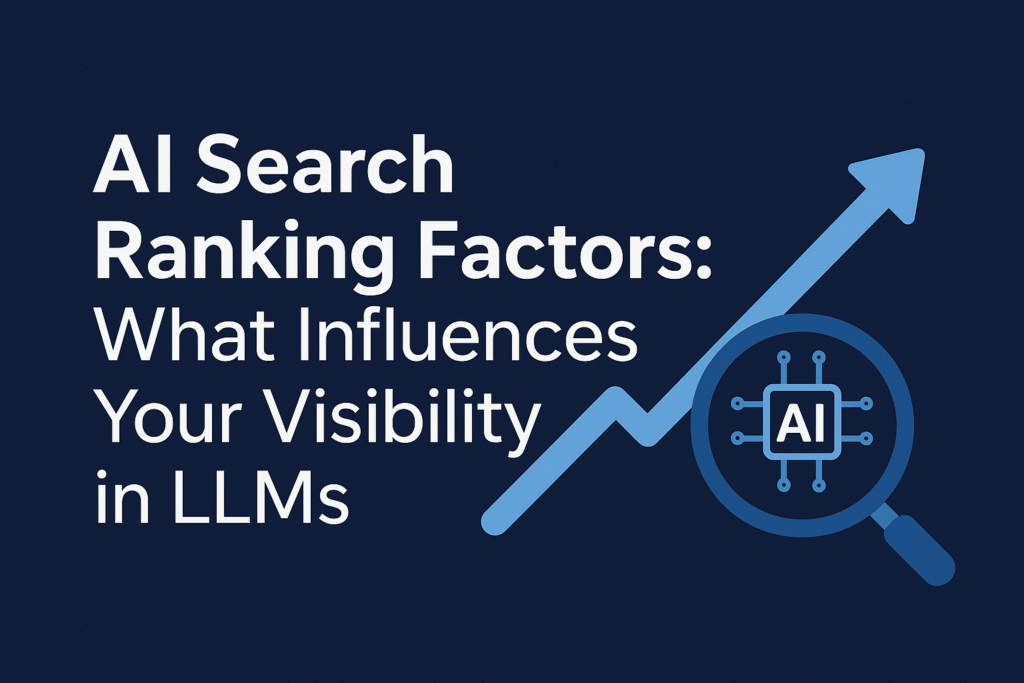In today’s rapidly evolving digital landscape, visibility is no longer just about ranking high on traditional search engines like Google. With the rise of AI-powered search and large language models (LLMs), content creators, marketers, and businesses must understand a whole new set of ranking factors that determine how their content appears in AI-generated results. This article explores AI search ranking factors and what influences your visibility in LLMs, helping you stay ahead in this emerging search paradigm.
Understanding AI Search in LLMs
AI search refers to the process where advanced artificial intelligence, particularly LLMs like GPT-4, Claude, or Grok, evaluates, interprets, and ranks content to answer user queries. Unlike traditional search engines, which rely heavily on crawling, indexing, and link-based authority, LLMs analyze the semantic meaning of content, context, and user intent to generate responses.
For example, if a user asks, “What are the best leased line providers in London?”, an LLM doesn’t just retrieve a static list of websites. Instead, it evaluates hundreds of sources, considers authority, relevance, and user intent, and delivers a response that best fits the query. This approach makes AI search far more context-driven, requiring content creators to rethink traditional SEO strategies.
Key differences between traditional search and AI-powered search include:
- Interpretation over indexing: LLMs focus on understanding content meaning rather than matching exact keywords.
- Dynamic responses: AI can synthesize information from multiple sources to generate a unique answer.
- Relevance to intent: Content that satisfies the user’s underlying intent ranks higher, even if it doesn’t contain exact keywords.
Key AI Search Ranking Factors
Several factors influence your visibility in LLM-generated search results. Let’s break down the most critical ones.
1. Content Relevance
Content relevance remains the foundation of AI search ranking. LLMs prioritize material that accurately matches the user’s intent. Unlike traditional SEO, which emphasizes keyword density, AI search evaluates:
- Semantic alignment: Does your content address the topic comprehensively?
- Depth of coverage: Are you providing detailed, actionable insights rather than superficial answers?
- Clarity and readability: Can the LLM parse your content easily to generate coherent responses?
For instance, an article explaining “AI search ranking factors” should cover everything from technical SEO to content authority, structured data, and user engagement to be considered fully relevant.
Actionable tip: Use topic clusters and semantic keywords to signal depth and relevance. Tools like GPT-based content analyzers can help ensure your material aligns with the search intent.
2. Authority & Trustworthiness
LLMs value content from authoritative and trustworthy sources. Authority is measured by:
- Citations and references: Credible external sources increase trust.
- Domain reputation: Established brands and well-known websites are preferred.
- Expertise signals: Content produced by subject-matter experts ranks better.
AI systems are trained on vast datasets that include credible websites and publications. Therefore, content from recognized authorities is more likely to be referenced in AI-generated answers.
Actionable tip: Build your authority by including accurate references, author bios, and citations. Collaborate with industry experts or feature guest contributors to strengthen credibility.
3. User Engagement Signals
Even though LLMs do not directly track click-through rates like Google, they infer user engagement indirectly through patterns like:
- How often a page is cited or referenced by other authoritative sources.
- Social media engagement and content sharing.
- Time users spend interacting with your content (dwell time) and return visits.
Higher engagement indicates content usefulness, which AI models consider when ranking and recommending answers.
Actionable tip: Create content that encourages interaction, sharing, and repeat visits. Interactive elements, multimedia, and practical examples can boost engagement.
4. Content Structure & Formatting
Structured content makes it easier for LLMs to extract meaning and deliver concise, accurate responses. Key structural factors include:
- Headings and subheadings: Proper H1-H3 tags help LLMs parse your content efficiently.
- Lists and tables: These make information scannable and enhance comprehension.
- Schema markup: Structured data improves AI’s ability to identify key content elements.
For example, a “Leased Line Providers in London” guide with tables comparing speeds, costs, and customer ratings allows AI models to provide precise answers to user queries.
Actionable tip: Use clear headings, bullet points, tables, and schema markup. Structured content improves AI readability and increases the likelihood of featuring in AI-generated snippets.
5. Freshness & Updates
AI models prioritize current and relevant content, especially for time-sensitive topics like technology, finance, or industry trends. Outdated content is less likely to rank in AI-generated responses.
- Update content regularly: Revise stats, case studies, and pricing information.
- Highlight new insights: Adding recent developments signals freshness.
- Monitor AI trends: Track emerging queries and update content accordingly.
Actionable tip: Maintain a content update schedule. Refreshing old posts improves visibility in LLM-generated answers.
6. Technical SEO Factors
While AI search focuses on semantics and intent, technical SEO still influences visibility indirectly. Factors include:
- Page speed and performance: Fast-loading pages improve user experience, which AI models interpret as content quality.
- Mobile-friendliness: LLMs prioritize content that is accessible across devices.
- Crawlability: Structured URLs, sitemaps, and clean HTML make content easier to parse.
Actionable tip: Audit your website for technical SEO issues. Tools like Google Search Console and Lighthouse can identify performance bottlenecks that affect AI visibility.
7. Brand Presence & Mentions
LLMs evaluate brand mentions and digital footprint as signals of authority and trustworthiness. Factors include:
- Consistency of brand across platforms (website, social media, PR).
- Mentions in authoritative publications and industry forums.
- Reviews and ratings from users.
A strong brand presence not only improves AI visibility but also increases the likelihood that LLMs reference your content in their generated answers.
Actionable tip: Build a consistent online presence. Engage in PR campaigns, industry collaborations, and social media outreach to strengthen brand signals.
Practical Tips to Improve Visibility in AI Search
Optimizing for AI search requires a multi-layered approach. Here’s how you can enhance your content’s visibility in LLMs:
- Focus on Semantic Relevance
- Cover topics comprehensively with supporting details and examples.
- Use semantically related keywords instead of overloading primary keywords.
- Cover topics comprehensively with supporting details and examples.
- Strengthen Authority and Trust
- Include accurate references, author credentials, and citations.
- Collaborate with experts to increase credibility.
- Include accurate references, author credentials, and citations.
- Structure Content for AI Parsing
- Use headings, bullet points, tables, and lists.
- Implement schema markup to highlight important content elements.
- Use headings, bullet points, tables, and lists.
- Update and Refresh Content Regularly
- Keep information current and aligned with user intent.
- Monitor AI trends to understand which queries are gaining traction.
- Keep information current and aligned with user intent.
- Optimize for Technical SEO
- Ensure fast loading, mobile-friendly design, and clean URL structure.
- Fix broken links and optimize internal linking.
- Ensure fast loading, mobile-friendly design, and clean URL structure.
- Enhance Brand Presence
- Leverage social media, PR, and online communities.
- Encourage user reviews, testimonials, and positive mentions.
- Leverage social media, PR, and online communities.
Challenges & Considerations
While optimizing for AI search offers tremendous opportunities, it also comes with challenges:
- Opaque ranking algorithms: LLMs do not provide exact ranking formulas, making precise optimization difficult.
- Balancing traditional SEO and AI content: Over-optimizing for AI might harm human readability and vice versa.
- Avoiding manipulative tactics: AI models can detect spammy or misleading content, which reduces credibility.
Success requires a strategic, user-first approach rather than chasing artificial ranking signals.
Conclusion
Visibility in AI-powered search is no longer just about keywords. Understanding AI search ranking factors—from content relevance and authority to structure, freshness, and brand presence—is critical for staying competitive in the age of LLMs. By focusing on semantic relevance, structured content, and credibility, you can increase the likelihood that your content is referenced by AI systems, reaching a wider audience and establishing authority in your niche.
Start auditing your content today, update it for AI search readiness, and embrace the evolving world of LLM-driven search.
Frequently Asked Questions (FAQ)
1. What are AI search ranking factors?
AI search ranking factors are the criteria that determine how content is evaluated and displayed by AI systems and large language models (LLMs). These factors include content relevance, authority, structure, user engagement, freshness, technical SEO, and brand presence. Understanding these factors helps ensure your content appears in AI-generated responses and reaches your target audience effectively.
2. How can I improve my visibility in LLMs?
To improve your visibility in LLM-powered search:
- Optimize content for semantic relevance by covering topics comprehensively.
- Build authority and trust with references, citations, and expert contributions.
- Structure your content clearly using headings, lists, tables, and schema markup.
- Regularly update your content to maintain freshness.
- Strengthen your brand presence online through social media, PR, and mentions.
3. How is AI search different from traditional SEO?
Unlike traditional SEO, which relies heavily on keywords, backlinks, and indexing, AI search uses LLMs to interpret the meaning and context of content. AI evaluates content for relevance, credibility, and user intent, often synthesizing information from multiple sources to deliver precise answers. This means that content must be semantically optimized and structured for easy understanding.
4. Why is content structure important for AI search?
Structured content helps LLMs parse and interpret your information effectively. Using headings, subheadings, lists, tables, and schema markup allows AI to identify key points, answer user queries accurately, and even feature your content in AI-generated snippets. Well-structured content is more likely to be referenced in AI responses.
5. Does updating content affect AI search visibility?
Yes. LLMs prioritize fresh and accurate information, especially for topics that change frequently. Regular updates improve your content’s relevance and ensure that AI systems reference the most current insights, which can increase your visibility in AI-generated results.

Joseph is an SEO Specialist and the founder of Search Engine Star, a results-driven SEO agency dedicated to helping businesses boost visibility, rank higher, and grow through smart search strategies. With years of experience in eCommerce SEO, AI-driven optimization, and SEO copywriting, Joseph has helped brands increase organic traffic and secure top spots in Google’s AI Overviews and featured snippets.

